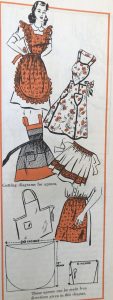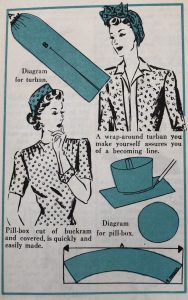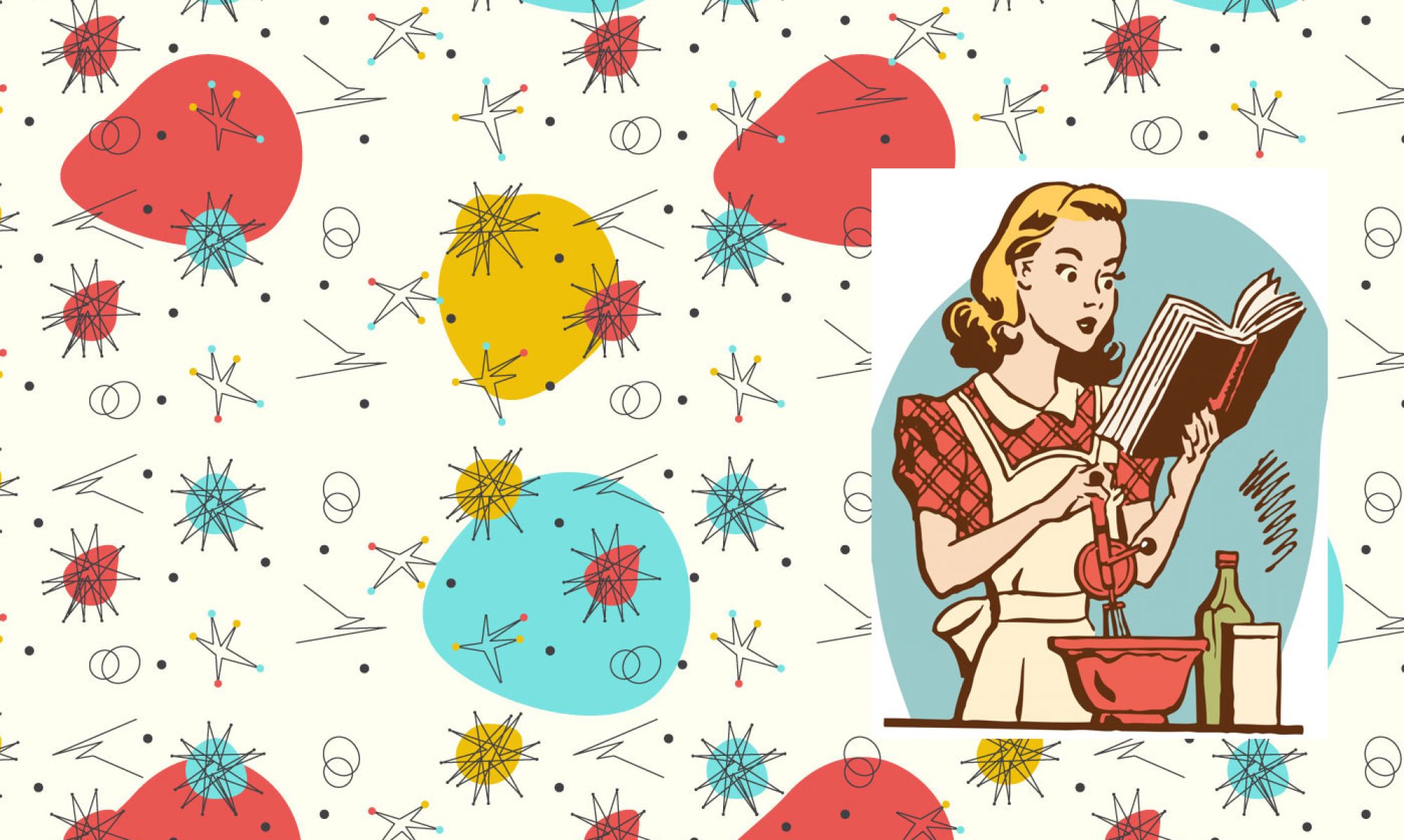Update: I went to a community book sale this week and found a 1972 edition of this 1943 book. While they have added all kinds of “mod” 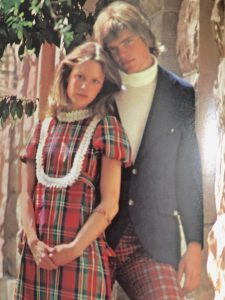 fashion they have
fashion they have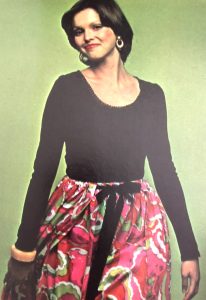 also kept a lot of the chapter topics, text and line drawings that were so helpful in the 1943 edition. One big difference in the two books is the dominance of stretch knit fabric. An exciting new concept in sewing at the time. I remember my mother’s delight as a lifelong sewist at finding the synthetic stretchy fabric she called Crimpoline at the end of the sixties because it was easy to sew and wash. I still have a bag to hold camping things made from old Crimpoline curtains. The stuff never wears out, but it might rot one day, I will see.
also kept a lot of the chapter topics, text and line drawings that were so helpful in the 1943 edition. One big difference in the two books is the dominance of stretch knit fabric. An exciting new concept in sewing at the time. I remember my mother’s delight as a lifelong sewist at finding the synthetic stretchy fabric she called Crimpoline at the end of the sixties because it was easy to sew and wash. I still have a bag to hold camping things made from old Crimpoline curtains. The stuff never wears out, but it might rot one day, I will see. 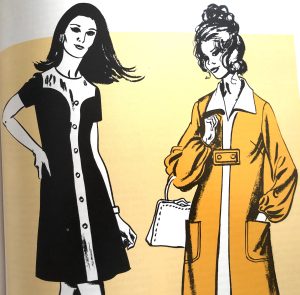 The chapters have mostly remained the same with updated photos,
The chapters have mostly remained the same with updated photos, 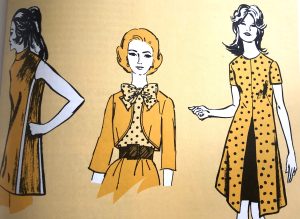 The restyling clothing chapter had a few new ideas such as taking a too short or too tight dress and shortening it into a tunic or adding a gore to the middle of a too tight dress. I looked to see what colour basics they suggested for the 1972 wardrobe but didn’t find it any mention of styles and colours in this edition.
The restyling clothing chapter had a few new ideas such as taking a too short or too tight dress and shortening it into a tunic or adding a gore to the middle of a too tight dress. I looked to see what colour basics they suggested for the 1972 wardrobe but didn’t find it any mention of styles and colours in this edition.
This fall we were clearing out my mother-in-law’s house as she moved into a senior’s apartment and we found a number of old books tucked into a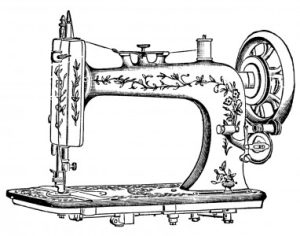 cupboard. One was a book designed to help the young woman of 1943 get started sewing her wardrobe and other items for her home. It is called , The Complete Book of Sewing. I own a couple of other books like this from the 1950s and even 1980s. They offer a lot of good advice for us new or experienced sewists even now. They are also a great walk through fashion history.
cupboard. One was a book designed to help the young woman of 1943 get started sewing her wardrobe and other items for her home. It is called , The Complete Book of Sewing. I own a couple of other books like this from the 1950s and even 1980s. They offer a lot of good advice for us new or experienced sewists even now. They are also a great walk through fashion history.
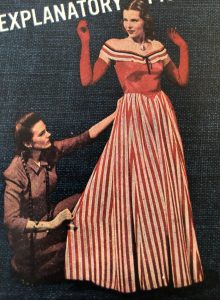
This book starts with the basics by saying every woman must choose her own style, decide the fabrics she likes and the fit that is flattering for her figure. This also is true for hats and accessories. This is key to creating a wardrobe that will last for years and help you look great everyday. A good piece of advice still valid all these years later is to always buy the best quality of fabric and workmanship you can afford. Fabrics need to be washable, easy care and made well. They warn young women not to buy the latest fashions just because they are new. They advise that you be honest when you look at a new fashion item and ask yourself if it is your style and if it is flattering on you. Clothes need to last a long time and need to be adaptable and practical too. While you might be able to tailor an ill fitting high fashion item you bought on a whim it is usually not going to be a great fit in the end. This is particularly good advice for us today as we live in a world where fast fashion is cheap, overnight delivery is easy and we have bloated wardrobes mostly full of low quality, often ill-fitting clothes. I think this 1943 advice suggests a better mindset about clothes than most of us have today.
you look at a new fashion item and ask yourself if it is your style and if it is flattering on you. Clothes need to last a long time and need to be adaptable and practical too. While you might be able to tailor an ill fitting high fashion item you bought on a whim it is usually not going to be a great fit in the end. This is particularly good advice for us today as we live in a world where fast fashion is cheap, overnight delivery is easy and we have bloated wardrobes mostly full of low quality, often ill-fitting clothes. I think this 1943 advice suggests a better mindset about clothes than most of us have today.
The book goes on to say there are three styles to choose from; sophisticated, feminine and tailored. These are not terms I know today but here’s how the book explains them:
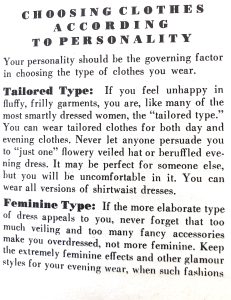
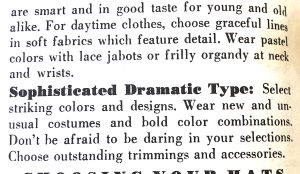
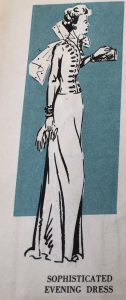
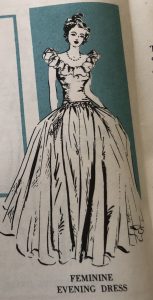
No example of a tailored evening dress was given, sadly.
A good wardrobe base was made up of a dress, coat, suit and evening wear. 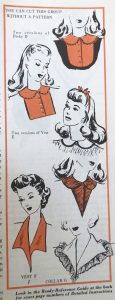 Other pieces like dickeys, blouses, scarves, sweaters and skirts would fill out the wardrobe. I will share some knitting and crochet patters for sweaters and purses in a post one of these days. Nice floral or abstract patterns should be chosen to go with many different outfits. Sports and work clothes were also part of most wardrobes. A neutral tone for wardrobe basics should be black, white, grey, beige or brown as they are the most practical and adaptable colours. You won’t get tired of a well tailored black suit. The book advises against bold colours for base items as they are harder to style.
Other pieces like dickeys, blouses, scarves, sweaters and skirts would fill out the wardrobe. I will share some knitting and crochet patters for sweaters and purses in a post one of these days. Nice floral or abstract patterns should be chosen to go with many different outfits. Sports and work clothes were also part of most wardrobes. A neutral tone for wardrobe basics should be black, white, grey, beige or brown as they are the most practical and adaptable colours. You won’t get tired of a well tailored black suit. The book advises against bold colours for base items as they are harder to style.
The book believes that hair colour and eye colour should be considered when choosing clothing.
| Hair colour | Best colours for clothing |
| Grey | Any colour but grey but nothing too showy |
| Blond | No strong colours and no yellow |
| Red | Green, blue, grey and brown |
| Black or White | Any colour even stronger shades |
| Eye Colour | Best colours for clothing |
| Blue/Green | Dress to match your eyes when possible |
| Brown/Grey | Brighter colours work well |
| Hazel/Grey/Brown | Yellow and green are most flattering |
I am old enough to remember the rage “getting your colours done” from the early 1990s. They are not totally different but the ideas above do not consider different skin tones. Not being inclusive in many, many ways is an obvious flaw in this 1943 book and honestly the mid-century as a whole.
Women in the 1940’s would think they would be sewing most of their clothing over their lifetime. So another important thing for them to learn was, what fabrics are best for what garments. Cotton for dresses and blouses, rayon blends for blouses, woollen suiting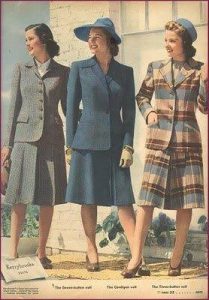 or tweed for suits and cotton and nylon for lingerie are best. Work clothes and aprons could be made from heavy cotton twill, denim or corduroy. The time of year the item will be worn is important too with woollen suiting for fall and winter and linen and seersucker for spring and summer. When choosing sewing patterns they reminded women to think about designs that are easy to adapt and change up and are styles that you will want to make over and over once you have tailored the pattern to be a perfect fit. Embroidery, applique, trims, buttons and closures can add style to a dress or suit. They also explain how scarves, bows, vests and dickeys can change the look of your suits and dresses.
or tweed for suits and cotton and nylon for lingerie are best. Work clothes and aprons could be made from heavy cotton twill, denim or corduroy. The time of year the item will be worn is important too with woollen suiting for fall and winter and linen and seersucker for spring and summer. When choosing sewing patterns they reminded women to think about designs that are easy to adapt and change up and are styles that you will want to make over and over once you have tailored the pattern to be a perfect fit. Embroidery, applique, trims, buttons and closures can add style to a dress or suit. They also explain how scarves, bows, vests and dickeys can change the look of your suits and dresses.
One piece of advice I hadn’t thought about but agree with is not to make undergarments or pyjamas out of bargain fabrics. These are items that will be washed often and worn everyday and need to stand up to the wear and tear. They should be comfortable to wear and perhaps need a bit of extra stretch or ease built into the cut of the garment. We all have learned the hard way that nothing is worse than ill-fitting underwear or pyjamas that don’t move when you do.
A whole section of the book was about restyling clothes. Printed during the second world war this is understandable as rationing or shortages weren’t just about food but were about clothing and fabric too. They suggested that adding new trim like new lace, buttons and accessories can make a suit look new. One of easiest ways to restyle a suit that is showing wear is to turn the fabric inside out and resew the seams. You could even remake a man’s suit into a woman’s suit. Taking your old suit or dress apart at the seams and recutting the neck, sleeves and skirt can create a pleasing new look too. 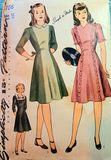 If your dress is too tight you can add a panel of a different fabric in the front, add matching sleeves and pockets or a ruffle at the bottom to make a coordinated look. This trick also was used to make ordinary dresses into maternity outfits. In another book I saw a similar idea about making girls dresses bigger and longer by adding new panels as the girls outgrew them but the dress fabric was not worn out. Clever ideas.
If your dress is too tight you can add a panel of a different fabric in the front, add matching sleeves and pockets or a ruffle at the bottom to make a coordinated look. This trick also was used to make ordinary dresses into maternity outfits. In another book I saw a similar idea about making girls dresses bigger and longer by adding new panels as the girls outgrew them but the dress fabric was not worn out. Clever ideas.
You can cut or swap out the sleeves of a blouse that is too tight to give it a better fit. You can cut the sleeves off a dress and deepen the armholes to make a jumper. Turning adult clothes into children’s garments was a thrifty thing to do, They suggested that a smart housewife should consider using sheets, blankets, tablecloths and curtains as fabric for home decor or clothing. Home or professional redying of clothing was another way of getting new life out of an old garment. So many ways to reuse and be environmentally conscious too, even if they didn’t have that in mind at the time.
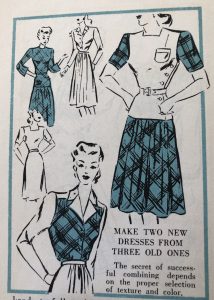
One particularly unusual suggestion, at least to me, is to take three dresses that do not fit well to make two new ones that do fit well. (Perhaps a young woman didn’t listen to the advice about the importance of style and fit instead of new fashion and had acquired three cheap, ill-fitting dresses.) As I understand it, if the top of one dress fits but the skirt doesn’t swap it out with a skirt that does and vice versa. Add bits of trim from the two prints to make it look coordinated. They do caution that sometimes a cheap or ill-fitting dress just isn’t worth the time and trouble of remaking, as it may never be comfortable or flattering. This would be particularly true if the fabric was poor quality. But of course any old clothing fabric can be used for children’s clothing or things like pillow covers or quilts. Nothing should be wasted.
What do you think about the advice for the young sewist? Are you wearing the right colour of neutral for your hair and eyes? I noticed that one of my standby neutrals being well. into middle age is navy, and it is not mentioned as a building block of a wardrobe.
Are you sophisticated, feminine or tailored? I am trying to wear more classic styles as I get older but I will admit I do love a vibrant pattern and strong colours like red , purple and royal blue.
I agree with the author that having a few good suits/coordinates and accessorizing them is still good advice for working women. It is a shame that we don’t use vests and dickeys anymore. They were easy to make and could really jazz up a boring outfit.
The reminder that cheap fabric never turns out to be a bargain is a good one. I am doing more sewing these days and find that is very true. However, these days when polyester and polyester blends are everywhere in fabric stores it is hard to find good natural fabric to sew with. In my opinion, cotton, linen or rayon while often hard to find are much better for most of the things I want to make to wear. They are also better for the planet.
Here are some apron and hat making ideas from the book as a bonus!
